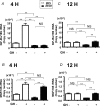Muscle mechano growth factor is preferentially induced by growth hormone in growth hormone-deficient lit/lit mice
- PMID: 15308683
- PMCID: PMC1665252
- DOI: 10.1113/jphysiol.2004.069500
Muscle mechano growth factor is preferentially induced by growth hormone in growth hormone-deficient lit/lit mice
Abstract
Two muscle insulin-like growth factor-I (IGF-I) mRNA splice variants (IGF-IEa and IGF-IEb) have been identified in rodents. IGF-IEb, also called mechano growth factor (MGF) has been found to be upregulated by exercise or muscle damage. Growth hormone (GH) is the principal regulator of IGF-I expression in several tissues including skeletal muscle. Therefore, we investigated the effect of chronic GH excess or disruption of GH receptor (GHR) signalling, and the acute effect of GH administration on expression of muscle IGF-I isoforms using transgenic mice that express bovine GH (bGH), GHR gene-disrupted (GHR-/-) mice and GH-deficient lit/lit mice before and after exogenous GH administration. MGF mRNA in skeletal muscle was increased in bGH mice whereas it was decreased in GHR-/- mice compared with control animals. Exogenous GH administration to dwarf lit/lit mice significantly increased muscle MGF but not IGF-IEa mRNA 4 h after treatment. Twelve hours after GH treatment, both MGF and IGF-IEa mRNAs in muscle were increased compared with vehicle-treated lit/lit mice. In contrast in GH-sufficient lit/+ mice, both MGF and IGF-IEa mRNAs were increased 4 h after and returned to the basal level 12 h after GH treatment. Hepatic IGF-I isoforms were regulated in parallel by GH. Thus, our results demonstrated that: (1) MGF mRNA in skeletal muscle is expressed in parallel with GH action; (2) MGF mRNA in muscle is produced preferentially in the situation of GH deficiency in contrast to the pattern in the GH-sufficient state; and (3) the induction of IGF-I isoforms by GH is tissue-specific.
Figures




Similar articles
-
Tissue-specific regulation of growth hormone (GH) receptor and insulin-like growth factor-I gene expression in the pituitary and liver of GH-deficient (lit/lit) mice and transgenic mice that overexpress bovine GH (bGH) or a bGH antagonist.Endocrinology. 2004 Apr;145(4):1564-70. doi: 10.1210/en.2003-1486. Epub 2004 Jan 15. Endocrinology. 2004. PMID: 14726438
-
Diurnal variation in growth hormone receptor messenger ribonucleic acid in liver and skeletal muscle of lit/+ and lit/lit mice.Endocr J. 2004 Dec;51(6):529-35. doi: 10.1507/endocrj.51.529. Endocr J. 2004. PMID: 15644570
-
Regulation of full-length and truncated growth hormone (GH) receptor by GH in tissues of lit/lit or bovine GH transgenic mice.Am J Physiol Endocrinol Metab. 2004 Sep;287(3):E566-73. doi: 10.1152/ajpendo.00110.2004. Epub 2004 May 27. Am J Physiol Endocrinol Metab. 2004. PMID: 15165994
-
MEAT SCIENCE AND MUSCLE BIOLOGY SYMPOSIUM--mechanism of growth hormone stimulation of skeletal muscle growth in cattle.J Anim Sci. 2014 Jan;92(1):21-9. doi: 10.2527/jas.2013-7095. Epub 2013 Oct 28. J Anim Sci. 2014. PMID: 24166991 Review.
-
Minireview: Mechano-growth factor: a putative product of IGF-I gene expression involved in tissue repair and regeneration.Endocrinology. 2010 Mar;151(3):865-75. doi: 10.1210/en.2009-1217. Epub 2010 Feb 3. Endocrinology. 2010. PMID: 20130113 Free PMC article. Review.
Cited by
-
Chronic alterations in growth hormone/insulin-like growth factor-I signaling lead to changes in mouse tendon structure.Matrix Biol. 2014 Feb;34:96-104. doi: 10.1016/j.matbio.2013.09.005. Epub 2013 Sep 28. Matrix Biol. 2014. PMID: 24080228 Free PMC article.
-
Skeletal muscle growth defect in human growth hormone transgenic rat is accompanied by phenotypic changes in progenitor cells.Age (Dordr). 2010 Jun;32(2):239-53. doi: 10.1007/s11357-010-9130-3. Epub 2010 Jan 23. Age (Dordr). 2010. PMID: 20431991 Free PMC article.
-
Chronic doxorubicin administration impacts satellite cell and capillary abundance in a muscle-specific manner.Physiol Rep. 2019 Apr;7(7):e14052. doi: 10.14814/phy2.14052. Physiol Rep. 2019. PMID: 30963722 Free PMC article.
-
Hormone replacement therapy and physical function in healthy older men. Time to talk hormones?Endocr Rev. 2012 Jun;33(3):314-77. doi: 10.1210/er.2012-1002. Epub 2012 Mar 20. Endocr Rev. 2012. PMID: 22433122 Free PMC article. Review.
-
The effect of training volume and intensity on improvements in muscular strength and size in resistance-trained men.Physiol Rep. 2015 Aug;3(8):e12472. doi: 10.14814/phy2.12472. Physiol Rep. 2015. PMID: 26272733 Free PMC article.
References
-
- Adams GR. Role of insulin-like growth factor-I in the regulation of skeletal muscle adaptation to increased loading. Exerc Sport Sci Rev. 1998;26:31–60. - PubMed
-
- Aperghis M, Johnson IP, Cannon J, Yang SY, Goldspink G. Different levels of neuroprotection by two insulin-like growth factor-I splice variants. Brain Res. 2004;1009:213–218. - PubMed
-
- Chakravarthy MV, Davis BS, Booth FW. IGF-I restores satellite cell proliferative potential in immobilized old skeletal muscle. J Appl Physiol. 2000;89:1365–1379. - PubMed
-
- Chen NY, Chen WY, Kopchick JJ. Liver and kidney growth hormone (GH) receptors are regulated differently in diabetic GH and GH antagonist transgenic mice. Endocrinology. 1997;138:1988–1994. - PubMed
-
- Chen Y, Hughes-Fulford M. Human prostate cancer cells lack feedback regulation of low-density lipoprotein receptor and its regulator, SREBP2. Int J Cancer. 2001;91:41–45. - PubMed
Publication types
MeSH terms
Substances
Grants and funding
LinkOut - more resources
Full Text Sources
Molecular Biology Databases

